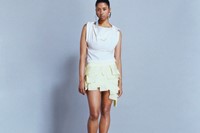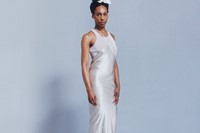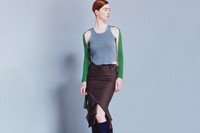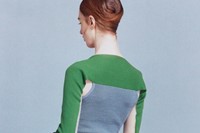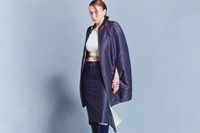Designed by stylist Hamish Wirgman and his assistant Kit Rimmer, the first collection from Gadhar is symbolic of the toppling amount of work that stylists are expected to achieve
Somehow, it’s become a universally accepted truth that fashion stylists’ lifestyles are inherently chic. Maybe we can thank those campy waifs in films like The Devil Wears Prada, or today’s stars on lengthy press junkets and front row at fashion shows with their stylists in tow. The myth is alluring, but a myth nonetheless – the reality for stylists and their teams is often far from elegant. Peek behind the garment and you might find a smattering of precariously placed safety pins barely holding a look together; look further, at the over-caffeinated assistant gritting their teeth because Look 12 is stuck in customs. It’s a way of life known all too well by stylist Hamish Wirgman and his assistant Kit Rimmer, who meet me in a cafe in Dalston to discuss their latest project. In September, the duo launched a fashion label called Gadhar: a love letter to their four-year working relationship, with a debut collection that enters the jumbled headspace of a stylist, realised with an accompanying magazine and exhibition at the Horse Hospital in Bloomsbury, London.
The inception of the label arrived two years ago, when Wirgman awoke from a fever dream where he’d found himself in the shadow of a precarious, towering smoked cork wedge. Swallowed by its sheer magnitude, he saw that pinned to the cork – as if it were a pinboard – was a lengthy to-do list, symbolic of the necessary admin that permits any creativity within the extraordinary workload of a stylist. Dreams like this aren’t unusual for Wirgman. “I don’t sleep much – I have acute ADHD, and my brain goes very fast. I worry a lot.” About work? “About everything. Most of my ideas come from my dreams, or in the sauna.” In order to find some semblance of order in the rustling whirlwind of receipts to expense and to-do lists, the duo quickly set out to produce that marvellous teetering wedge. This was the first piece for their soon-to-be first collection released under a yet-to-be-christened label. “All of a sudden, we’re doing nine looks. All of a sudden, we’re doing a magazine. And all of a sudden, we’re doing an event,” says Wirgman. “It all got a bit out of hand.”
Wirgman’s work in fashion tends to pack a punch in its meditative narratives. Stylists often find themselves at the whim of advertisers and tricky photographers, meaning their shoot mood boards are reduced down to elementary, one-word concept themes: floral dresses, perhaps some kinky latex, or an exploration of the colour ‘red’ – but not Wirgman. “We’d much rather red was worn during the spring of 1942 by a small group of women,” says Rimmer. True to form, across its two-year development, the inaugural collection became decidedly complex. Couture techniques are applied to a tracksuit top with a winding seam descending from the shoulder, while luxe ribbed knitwear finds itself on a humble red bralette. A bomber jacket swathes and swaddles the body, fitted with discrete arm slits that Hubert de Givenchy would approve of, while a pencil skirt’s closure is an elaborate spiralling lineup of miniature blue buttons.
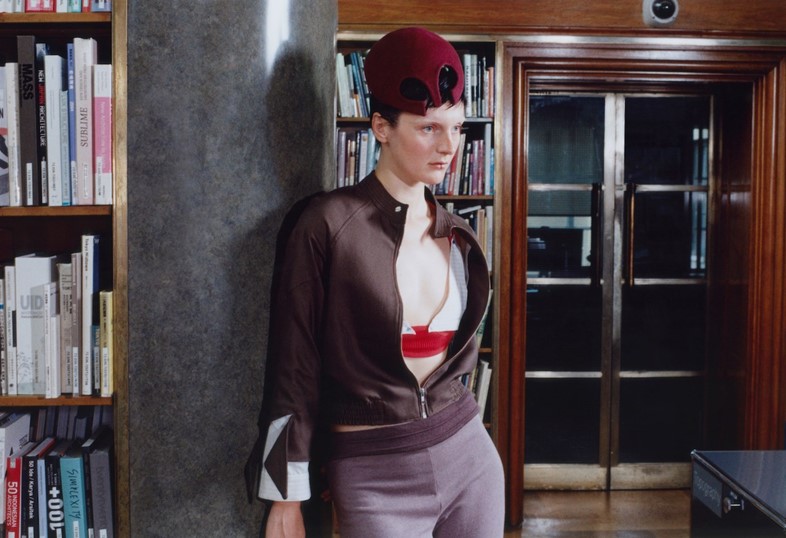
Post-it notes crop up throughout, which instead of paper are fashioned from squares of a lurid yellow nylon. “Hamish hates things written down on a phone, so [written] to-do lists have always been part of our system,” says Kit. “I write notes in every meeting, for every phone call,” adds Wirgman. “I love a to-do list, and I love ticking [things off].” This tick motif makes its grand entrance in the final look – a four-metre-long satin checkmark transformed into a bias-cut gown sewn using a Halston-esque single seam, with a train asymmetrically swooping to one side. Silver jewellery pieces are fitted with real biro nibs, perfect for ticking off checklists on the go. The aim of Gadhar isn’t a relentless inventiveness, nor an energising new way of dressing learned from years of playing with clothes on the body – more so a vehicle to tell a true story with cultivated conviction.
Meaning ‘greyhound’ in Gaelic, the label’s name stems from the duo’s Celtic roots, along with the simple fact that they both like dogs. “I feel like we could over-intellectualise it, but I don’t think me and Kit are very cool,” Wirgman says, his cycling gear rustling as he slices up a sourdough lunch. “We’re more like dogs in that we like to please. You ask us a question and we’ll give you what you want.” Rimmer adds: “Or what we think you’ll want.” And delivering on promises is part and parcel of being a stylist. It’s an intensely collaborative job, working with photographers, talent, hair stylists, make-up artists, models, all of whom are hungry for the largest slice of the pie in the final creative output. “There’s a degree of frustration,” Wirgman admits, “but all of a sudden [with Gadhar], I became the will of my own idea.”
Instead of sending the looks off for production, Gadhar created a magazine to bind the collection into one publication. In keeping with the collection, the magazine resembles an A5 notebook, with its thin blue-lined paper that echoes prints on shirting and dresses. Its pages play host to further collaborations, including a series of still lifes by Carl Gustaf von Platen, prose by George Lynch, illustrations by Anna Pye, and an editorial captured by Joanna Wzorek. Stapled to its back cover is a receipt, listing and thanking each collaborator who brought the collection to life. “I’m not used to being at the top rung where everybody was helping me out – where all of a sudden I’m asking people for favours. Everybody seemed happy. Unless they’re all bitching about me now.”

Gadhar’s short exhibition at Horse Hospital – an 18th-century venue built for stabling cab drivers’ sick horses – offered an opportunity to view the collection up close. “The floors are these wonderful huge blocks of stone with lines carved in to drain the horse piss and blood. It was nice to create this cosy environment. There wasn’t much room – it was cordoned off with these mannequins covered in sticky notes we had spent the whole day doing,” says Wirgman. The spectacle was soundtracked by the ambient noise of an office to create what felt like a confined work environment, where the collection can be wooed at, studied, but not touched. “It’s very precious,” Wirgman adds. “That’s the reason I won’t lend it out.”
Like much of their generational cohort, the duo grew up with a love for the fashion of the 90s, spearheaded by designers like John Galliano and Alexander McQueen whose inspiration nestles its way into sharp tailoring and anti-convention spirit. There’s a sense of glamour in those shapes and fabrications, too. Turning those vulnerable moments in the studio into a ravishing collection, the duo unearth beauty in silk and jersey rib from a whirlwind of creased and crumpled paper receipts and old to-do lists. “It’s funny that we’ve established a brand and created imagery and a logo, but there’s something quite un-brandlike in the way we’ve gone about it. It’s early days, we’re figuring it out,” says Rimmer. With a firm and confident visual vocabulary from the outset, from here on it’s a matter of fine-tuning, as Wirgman explains, “the next collection will be a little more focused. A full wardrobe is incredibly taxing, and I definitely would like to sell some things.”

